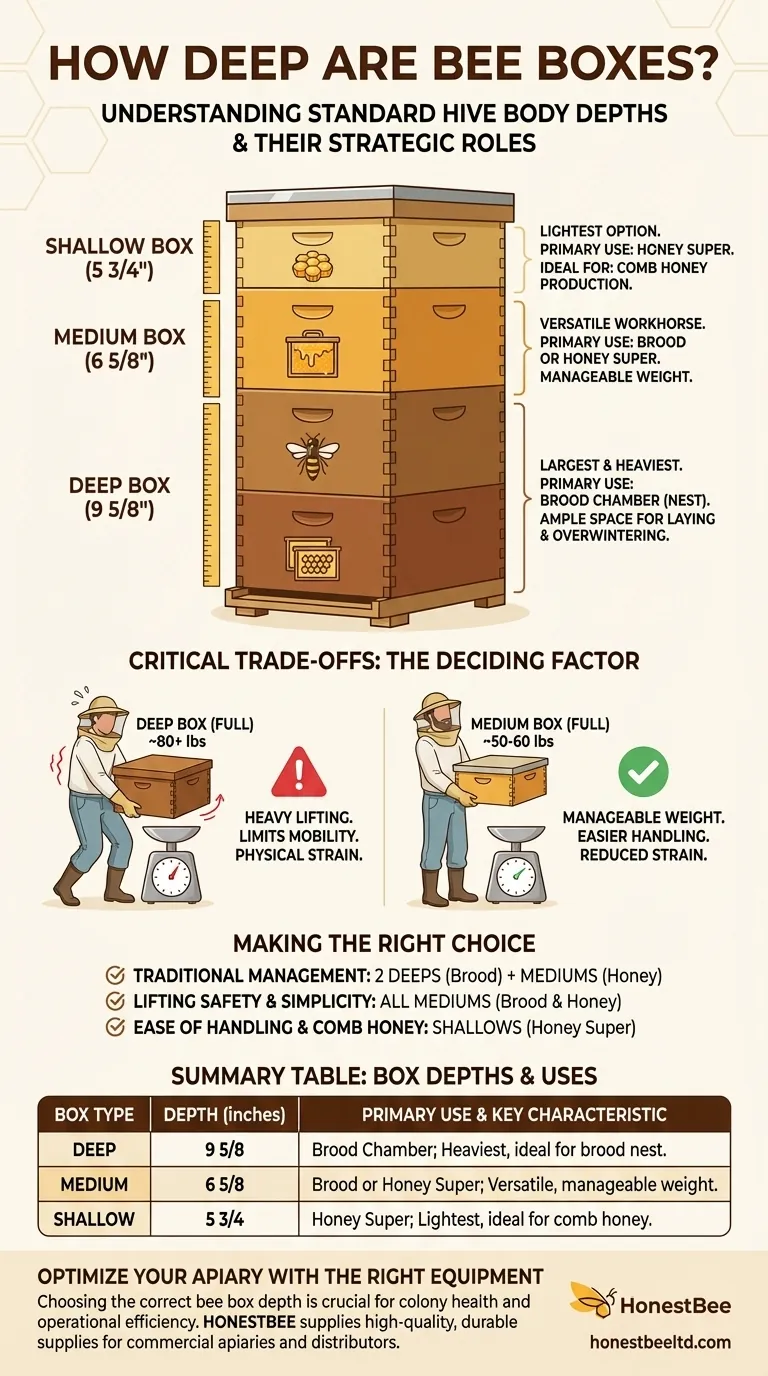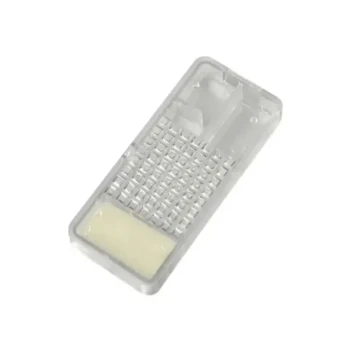To be precise, standard bee boxes, also known as hive bodies or supers, come in three common depths. A deep box is 9 5/8 inches deep, a medium box is 6 5/8 inches deep, and a shallow box is 5 3/4 inches deep. Beekeepers traditionally use one or two deep boxes at the bottom of the hive to serve as the brood nest where the queen lays her eggs.
The depth of a bee box is not just a measurement; it's a strategic choice that directly impacts hive management, honey yield, and, most importantly, the physical lifting required by the beekeeper.

The Role of Each Box Size
The modern beehive is a modular system. Understanding the purpose of each module size is fundamental to successful beekeeping.
Deep Boxes (9 5/8")
These are the largest and heaviest boxes. Their significant volume provides ample space for a queen to lay eggs and for the colony to cluster during winter.
A typical hive configuration uses two deep boxes stacked on top of each other to form the brood chamber, the heart and engine of the colony.
Medium Boxes (6 5/8")
Also called "Illinois Supers," medium boxes are the versatile workhorse of the hive. They are significantly lighter than deeps when full of honey.
Many beekeepers use mediums exclusively for honey supers—the boxes placed above the brood chamber to store surplus honey. Some even use mediums for their entire hive, including the brood nest, to standardize equipment.
Shallow Boxes (5 3/4")
As the lightest option, shallow boxes are used almost exclusively for honey supers.
Their smaller size is particularly advantageous for producing specialty items like comb honey, where a perfect, complete frame of honey is desired.
Understanding the Critical Trade-offs
Choosing a box size is a decision you will live with for every hive inspection and harvest. It involves balancing the needs of the bees with the physical limitations of the beekeeper.
The Deciding Factor: Weight
This is the most critical trade-off. A deep box filled with honey can weigh over 80 pounds, while a full medium box weighs around 50-60 pounds.
This weight difference is a major reason why many beekeepers prefer using medium boxes for honey supers, as lifting multiple 80-pound boxes can be physically prohibitive.
Hive Volume vs. Management
A two-deep brood chamber gives a prolific queen a vast, unbroken area to lay, which can lead to a very strong colony.
However, managing a hive made entirely of medium boxes simplifies your equipment needs. You only need to purchase and maintain one size of box and one size of frame.
Inspection and Interchangeability
Using a single box size for the entire hive allows any frame to be moved to any position. This offers incredible flexibility during inspections.
For example, you can move a frame of honey from the top of the hive down to the brood nest if the colony is low on food, an action that isn't possible when mixing deep and medium frames.
Making the Right Choice for Your Goal
Your beekeeping philosophy and physical ability should dictate your equipment choices.
- If your primary focus is traditional hive management: Use two deep boxes for the brood chamber and medium boxes for your honey supers.
- If your primary focus is lifting safety and equipment simplicity: Run your entire hive using all medium boxes for both brood and honey.
- If your primary focus is ease of handling or comb honey production: Use shallow boxes for your honey supers.
Ultimately, understanding these dimensions empowers you to build a hive that works effectively for both your bees and you.
Summary Table:
| Box Type | Depth (inches) | Primary Use | Key Characteristic |
|---|---|---|---|
| Deep | 9 5/8 | Brood Chamber | Heaviest; ideal for brood nest |
| Medium | 6 5/8 | Brood or Honey Super | Versatile; manageable weight |
| Shallow | 5 3/4 | Honey Super | Lightest; ideal for comb honey |
Optimize Your Apiary with the Right Equipment
Choosing the correct bee box depth is crucial for the health of your colony and the efficiency of your operation. At HONESTBEE, we supply high-quality, durable beekeeping supplies and equipment designed specifically for the demands of commercial apiaries and beekeeping equipment distributors.
We understand that your success depends on reliable, standardized equipment that minimizes physical strain and maximizes honey production. Our wholesale-focused operations ensure you get the best value on the boxes and frames that are right for your specific goals.
Let us help you build a more productive and manageable hive.
Contact HONESTBEE today to discuss your equipment needs and wholesale pricing.
Visual Guide

Related Products
- Australian Langstroth Beehive Boxes for Beekeeping Wholesales
- Langstroth Bee Hives Bee Keeping Box for Beginners Beekeeping
- Langstroth Honey Bee Box Hive Boxes for Different Depths
- Professional Insulated Plastic Bee Hives
- Portable Bee Mating Hive Boxes Mini Mating Nucs 8 Frames for Queen Rearing
People Also Ask
- What are the sizes of supers available in a standard hive? A Guide to Deep, Medium, and Shallow Boxes
- How many frames fit into a standard beehive box? Choose Between 8-Frame and 10-Frame Hives
- What are the three types of beehives? Find the Perfect Hive for Your Beekeeping Philosophy
- What is the best hive for beginners? A Guide to Langstroth, Top Bar, and Flow Hives
- What other types of hives are available besides the Flow Hive? Explore Langstroth, Top Bar, and Warre



















